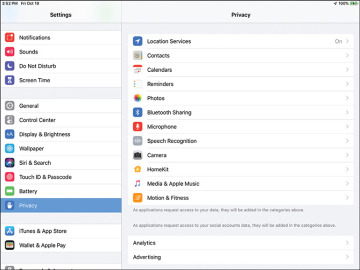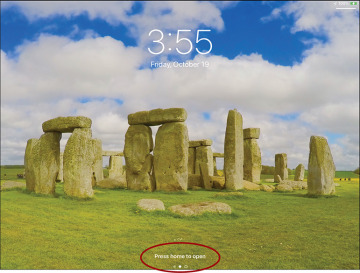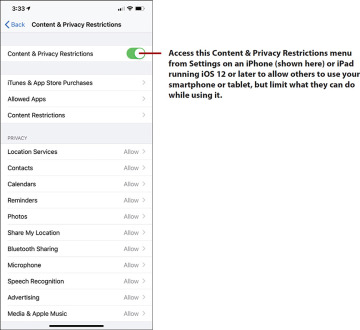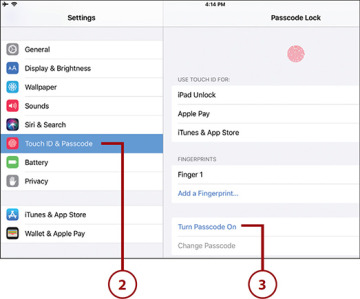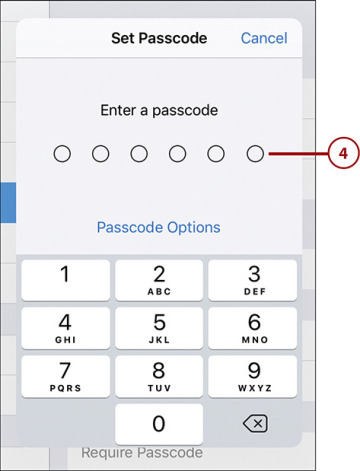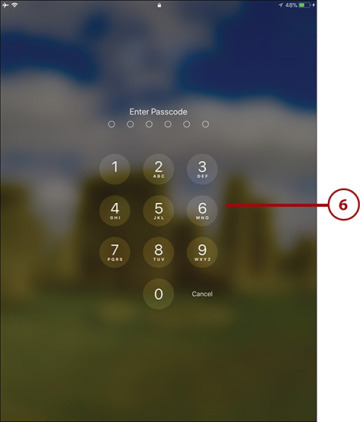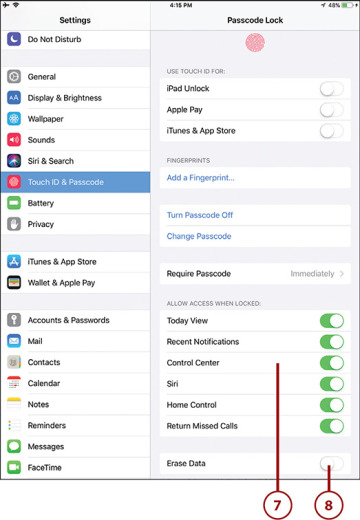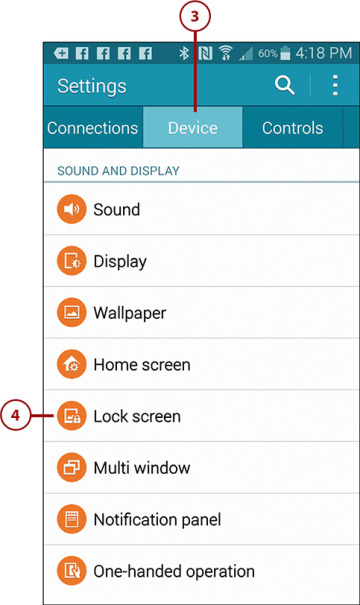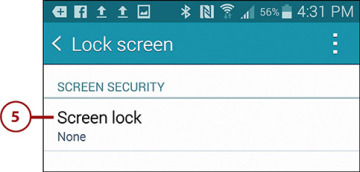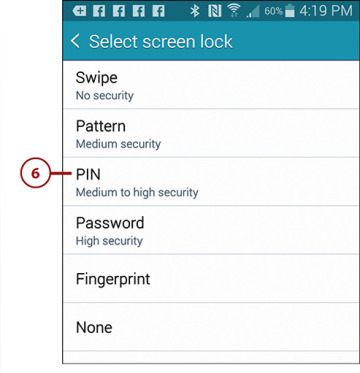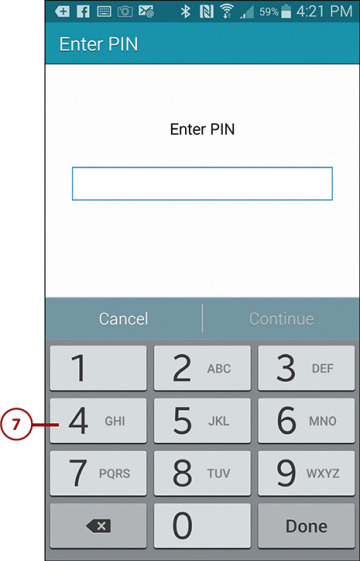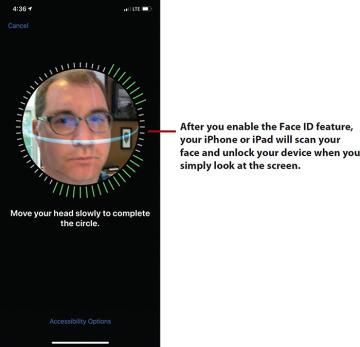- Preventing Unauthorized People from Using Your Mobile Device
- Taking Advantage of Parental Controls
- Adjusting the App-Specific Privacy Settings on Your Mobile Device
- Keeping Your Mobile Device's Operating System and Apps Up to Date
- Managing Your Mobile Device's Wireless Connections
- Blocking and Managing Unwanted Calls to Your Smartphone
Learn how to use and customize the security and privacy features built in to your smartphone or tablet.
In this chapter, you’ll learn how to use the security and privacy features built in to your smartphone or tablet. Topics include:
An overview of the privacy and security settings built in to the operating system of your mobile device
Which privacy settings to manually adjust and why it is important
How to set up the passcode, fingerprint, or face identification sensors built in to your smartphone or tablet that can keep unauthorized people from accessing your device
How to manage and block unwanted calls to your smartphone
With your iPhone, iPad, or Android-based mobile device, you can handle a wide range of commonly used tasks—from accessing your email, to checking the weather forecast, to handling online banking. Plus, thanks to its built-in GPS (Location Services) feature, your smartphone or tablet always keeps tabs on where you are. This information is used in many ways. For example, your current location details are used with GPS apps (whether Google Maps, Maps, or third-party apps) to provide you with real-time navigation information or to pinpoint your location each time you snap a photo using the device’s built-in camera.
Your smartphone or tablet often shares this information between apps, cloud-based services, and online services (including social media services)—sometimes without your knowledge.
If you’re like most people and store personal and private information in your mobile device, you’ll definitely want to take steps to protect it and keep unauthorized people from using your smartphone or tablet or from intercepting content that the mobile device sends or receives via the Internet.
Preventing Unauthorized People from Using Your Mobile Device
Almost all smartphones and tablets have multiple levels of security that allow you to lock the device, and then allow only an authorized user to unlock and access it. When all these security features are turned off, anyone can pick up, turn on, and start using your mobile device and potentially access any information stored in it. Those same people could launch the mobile device’s web browser and sign in to websites as you, if you have your website/online service usernames and passwords stored by the web browser.
To prevent random people from picking up your smartphone or tablet and having full access to everything stored in it, at the very least, turn on the Passcode (iOS)/PIN (Android) feature. For added convenience and more security, consider turning on the Touch ID (fingerprint scanner) or Face ID (face scanner).
The Touch ID sensor is built in to the Home button of older iPhone and iPad models. The newest iPhones and iPads have a face recognition camera built in, and no Home button.
If you know other people will be using your smartphone or tablet (with permission), but you want to limit what apps, features, functions, and data those other people can access, turn on the device’s Content & Privacy Restrictions-related features.
Setting Up the Passcode Feature
The Passcode/PIN feature displays your mobile device’s Lock screen each time your device is turned on or awakened from sleep mode. The person who turned on the device will need to enter a four- or six-digit passcode (that is, an alphanumeric password) to unlock the smartphone or tablet and begin using it.
On an iPhone, iPad, or Android-based mobile device, the Passcode/PIN feature needs to be turned on and set only once. You can later change the passcode.
Set the Passcode (iPhone or iPad)
To turn on and use the Passcode feature on your smartphone or tablet (running iOS 12 or later), follow these steps:
Turn on the iPhone or iPad, and from the Home screen, tap Settings (shown here).

Scroll down and tap the Touch ID/Face ID & Passcode option.
Tap the Turn Passcode On option. (To change your passcode, tap the Change Passcode option.)
Type in a six-digit numeric passcode when the Set Passcode window appears.
Confirm the passcode. (Not shown.)
After you exit Settings, when you turn on the mobile device or awaken it from sleep mode, the Lock screen will appear and you’ll be prompted to enter the correct code to unlock the device.
From the Touch ID/Face ID & Passcode submenu in Settings, you can adjust a handful of options that determine what can be viewed or done from the Lock screen without first unlocking the device.
If you turn on the Erase Data option, if someone attempts to unlock your iPhone or iPad using an incorrect passcode ten times in a row, the device will automatically erase itself (to protect your data). As the mobile device’s owner, you can later restore your content from an iCloud backup.
Set the PIN (Android)
To turn on and use the PIN feature on your Android-based smartphone or tablet, follow these steps:
Turn on the smartphone or tablet. (Not shown.)
From the Home screen, tap the Settings icon.
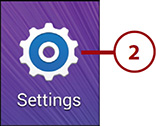
From the Settings menu, tap the Device tab.
Tap the Lock Screen option.
Under the Screen Security heading, tap the Screen Lock option.
Tap the PIN option.
Enter at least a four-digit numeric code, and then tap Done.
Confirm the numeric code by typing it in a second time, and then tap Done. (Not shown.)
After you exit Settings, when you turn on the mobile device or awaken it from sleep mode, the Lock screen will appear and you’ll be prompted to enter the correct code to unlock the device. (Not shown.)
Turning On the Touch ID (iOS) or Finger Scanner (Android)
Some mobile devices also have a fingerprint scanner built into the Home button. After users scan their fingerprint once, they can later unlock their smartphone or tablet by placing their finger on the Home button. (On some Android devices, you need to swipe your finger over the Home button.)
Scanning your fingerprint to unlock your device is often quicker than typing in a passcode. When setting up this feature, you’ll need to scan each finger that you want the smartphone or tablet to recognize. Consider scanning your thumbs and pointer fingers separately, so no matter how you’re holding the device, it’s always convenient to scan a fingerprint.
When you first set up a smartphone or tablet that has a Home button built in, you’ll be guided to set up the Touch ID (iOS) or Fingerprint Scan (Android) feature. This can also be done later.
Activating Touch ID (iPhone or iPad)
To turn on or off the Touch ID feature on an iPhone or iPad that has a Home button, launch Settings, tap the Touch ID & Passcode option, and then turn on or off the Passcode option (which controls the Passcode and Touch ID feature). To add more fingerprint scans to the device, tap the Add a Fingerprint option, and follow the onscreen prompts.
Activating Fingerprint Scan (Android)
To turn on/off the Fingerprint Scan feature on an Android-based mobile device, launch Settings, tap the Device tab, tap the Lock Screen option, and then tap the Screen Lock option. From the Select Screen Lock menu, choose the Fingerprint option to activate the fingerprint scan option, or choose the None or Swipe option to turn off this security feature altogether.
Depending on the make and model of your Android-based smartphone or tablet, other options for unlocking the device, including Password or Face Recognition, may be available.
Taking Advantage of Face ID (iOS)
Newer iPhone and iPad models that do not have a Home button have a camera located on the front of the device that is able to scan your face and identify you when you simply look at the screen.
The Face ID feature can be turned on during the device’s initial setup process or later; just tap Settings, and tap the Face ID & Passcode feature.
Restricting Access to Apps and Content
Also referred to as “Parental Controls,” the Content & Privacy Restrictions feature built in to the iPhone or iPad allows you to permit other people to use your smartphone or tablet, but access only specific apps or content that you pre-determine. This feature is ideal if you plan to allow children to use your mobile device, but want them to be able to use only specific apps, enjoy specific types of content, or access only certain websites.
To manage the Content & Privacy Restrictions on an iPhone or iPad (running iOS 12 or later), follow these steps:
Launch Settings
Tap the Screen Time option.
Tap the Content & Privacy Restrictions option.
Tap the Content & Privacy Restrictions option at the top of the screen to turn it on, and then tap each menu option to manage access to specific apps and content.

